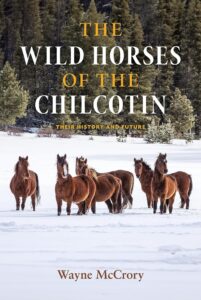Book review: The Wild Horses of The Chilcotin: Their History and Future
 Reviewed by Carrie MacKenzie
Reviewed by Carrie MacKenzie
The Wild Horses of The Chilcotin: Their History and Future by Wayne McCrory is a non-fiction book that outlines two decades of research into the impact of wild horses on their environment. It also looks at the relationship with other flora and fauna, both domestic and wild (humans included).
McCrory is a registered professional biologist specializing in the study of wild horses, bears and western toads. McCrory begins with a section titled, Professional Qualifier, were he outlines his professional qualifications and experience. He also highlights his consultations with experienced Tsilhqot’in and Tsilhgot’in Elders who aided with research and fact-checking. Additionally, he had another practising biologist fact-check his results, which also adds to the research credibility.
The accessibility of this research is further enhanced by the language used. It is used and understood by everyone; even though this book references the results of scientific research, it is accessible to readers without a scientific background. McCrory uses these results to back up the assertions he makes, giving validity to his writing. It also gives the information to critically analyze the reasons those in favour of culling wild horses use to promote their views.
This study also has an educational component as McCrory writes about the history of the wild horse’s arrival in North America and the different ways they may have arrived there. This is a part of history that is not common knowledge and its inclusion is a learning opportunity for the reader. This leads into a discussion about the future of these wild horses. Furthering this, there are end-notes for each chapter with resources that were used and information that the reader can use to learn more about this topic.
This book has an environmental protection theme and highlights the different priorities Indigenous people have compared to their non-Indigenous counterparts. This is strengthened by the author’s research and the inclusion of a synopsis of the horse protection inventories of provinces and territories with wild horse populations.
This study also includes pictures of the wild horses being studied and the wolves and bears living alongside them. This brings these horses and their plight to life, deepening the connection the reader feels to the wild horses being studied; they cease to be random horses living far away.
Adding to the impact of the photos is the inclusion of pictures of the individuals who helped McCrory with his research. The Elders who taught him about the cultural importance of the horse to the Tisilhqot’in people were also featured, allowing the reader to put faces to the names of those who helped with the research, bringing them to life and creating an emotional connection, making it harder for them to remain detached from the message in the book.
The tone of this work is serious but there are humorous moments too, as seen in the personal anecdotes included in the book. This keeps the reader engaged and able to absorb the message of McCrory’s book.
The pace of this book adds readability as it moves forward at a rate that keeps the audience engaged while allowing them time to process and learn from the information being presented.
The Wild Horses of The Chilcotin: Their History and Future is engaging and informative. It would be an asset to any library and of interest to those intrigued by history and horses.
Wayne McCrory, The Wild Horses of The Chilcotin: Their History and Future. Pender Harbour: Harbour Publishing, 2023.
ISBN: 97819990776366


